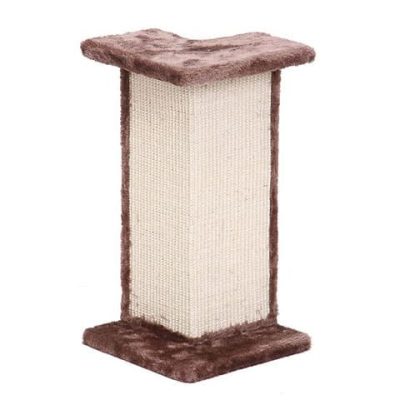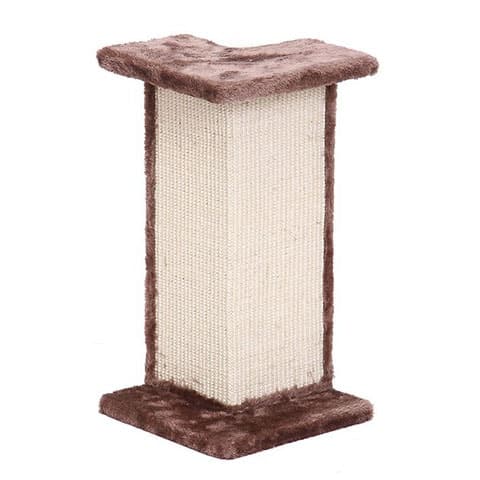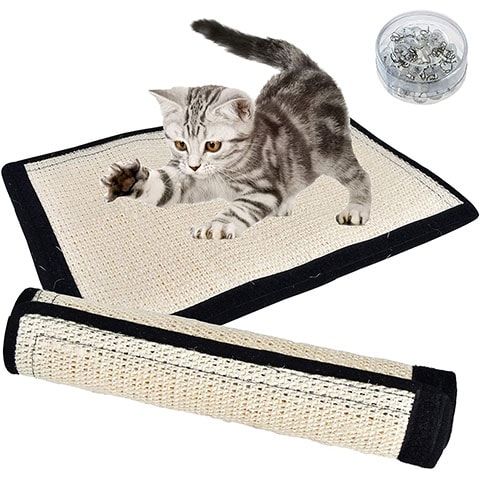
For our cats, scratching is an instinctive behavior. While it might be irritating to notice a few claw marks on the side of your couch, scratching serves a few important purposes for our cats. It helps them remove the outer dead layer of their claws, gives their muscles a chance to flex, and allows them to leave pheromones from the scent markers on their paw pads.
As responsible cat owners, we must ensure our furry friends have plenty of opportunities to scratch different surfaces around our homes. Investing in one or more scratching posts is the best way to achieve that. They give your cat suitable surfaces to indulge in this instinctive behavior and keep your furniture safe from their claws!
If you’re unsure where to start, corner cat scratchers are a great choice. They sit either in a corner or up against pieces of furniture. This allows your cat to stretch and scratch to their heart’s content! Our reviews are designed to make choosing which product to buy easier than ever. We’ve rounded up our favorite corner cat scratchers below.

A Quick Comparison of Our Favorites in 2024
| Image | Product | Details | ||
|---|---|---|---|---|
| Best Overall |

|
Penn-Plax Corner Wall 30-in Sisal Cat Scratcher |
|
CHECK PRICE |
| Best Value |

|
VIILER Fashionable Cat Scratcher Pad |
|
CHECK PRICE |
| Premium Choice |

|
Sofa-Scratcher Squared' Cat Scratching Post |
|
CHECK PRICE |

|
Sofa-Scratcher Cat Scratching Post & Couch-Corner |
|
CHECK PRICE | |

|
Milky House Store Cat Corner Scratch Pad |
|
CHECK PRICE |
The 5 Best Corner Cat Scratchers
1. Penn-Plax Corner Wall 30-in Sisal Cat Scratcher — Best Overall

You won’t regret investing in this space-saving cat scratcher we chose as our best overall pick. The two-sided design fits neatly into a corner, which is the perfect choice for smaller homes or when you don’t want your cat scratcher to dominate the space in a larger house. The combination of natural sisal rope and plush carpet is one that most cats love.
This cat scratcher is 30 inches tall and big enough for most breeds. The top is covered with carpet and doubles as a perch so your cat can watch the world go by in comfort. Another way to use this scratcher is by placing it up against the arm of a couch rather than in a corner. This is a great way to stop your cat from scratching your furniture while being free to carry out this natural behavior.
- Space-saving design
- Tall enough for large cats
- Includes perch at top
- Uses natural sisal
- None that we can see
2. VIILER Fashionable Cat Scratcher Pad — Best Value

If you’re looking for the best corner cat scratcher for the money, this multi-purpose option by VIILER is our recommendation. This flexible mat can be wrapped around couch corners or table legs or even fixed into the corner of a wall to give your cat something to scratch without damaging your furniture. It measures 15.8 inches by 12.3 inches.
It has a natural sisal rope front and a Velcro backing that adheres to most soft surfaces. If you want to attach it to your wall, you may need to use glue. Some strong and large cats may end up pulling it off whatever surface it’s attached to, so you may need to reposition it every now and again. But in terms of value for money, it can’t be beaten!
- Great value for money
- Can also be used flat
- Velcro backing
- Uses natural sisal rope
- Doesn’t stick to some surfaces
3. Sofa-Scratcher Squared’ Cat Scratching Post — Premium Choice

If you’re looking for a premium corner cat scratcher that your cat will love but is stylish and subtle enough to suit any décor, the Sofa-Scratcher Squared’ Cat Scratching post is our pick. It comes in nine colors, from white to charcoal, and plenty of neutral options. It is designed to fit exactly where your cat loves to scratch the most: on the arms of your couch!
The Scratcher Squared’ is designed to fit the 90-degree corners on the front and rear of your couch. It has a low-profile base that slides under the leg of your couch, keeping it securely anchored in place. Reviewers love how stylish this scratching post is, as well as how well-made and functional it is. Your cat can still scratch their favorite spot, but now your couch is protected, and everyone is happy!
- Made from premium sisal fabric
- Handmade in the U.S.A.
- Approved by veterinarians
- Fits most couches
- Expensive
4. Sofa-Scratcher Couch-Corner Cat Scratching Post

The Sofa-Scratcher Cat Scratching Post & Couch-Corner is covered in high-quality woven sisal fabric and is designed to fit couches with wide, rounded arms. This cat scratcher can only be used when secured by fitting the base under the arm of a couch, so if you’re looking for a scratcher that could also be placed against the corner of a wall, this one isn’t heavy enough and will likely fall over.
This cat scratcher allows your cat to scratch in their preferred location without worrying about your couch getting damaged. The soft felt backing protects your furniture, while the sisal fabric outer feels great to your cat. The neutral colors will suit any home, and the height of this scratcher makes it perfect for large breed cats that like a full-body stretch.
- Made in the U.S.A.
- Uses high-quality sisal fabric
- Suitable for rounded couches
- Cannot be used on its own
5. Milky House Store Cat Corner Scratch Pad

The Milky House Store Cat Corner Scratch Pad is the ideal solution if you want to protect all kinds of furniture from your cat’s claws. This flat mat is made using sisal fabric and can be wrapped around table legs or couch arms or left flat on the floor. In each pack, you get two mats measuring 16 inches by 12 inches. It also comes with a pack of specially designed nails, which can be used to secure the mats to couch arms without damaging them.
Each mat is Velcro-backed, and depending on the type of fabric that you want to attach the mat to, you may be able to secure it that way as well. It’s worth noting that the Velcro isn’t that strong, so you may find that your cat pulls the mat down if you don’t use the nails.
- Good value for money
- Easy to attach to furniture
- Sisal fabric is quite thin
- Velcro isn’t that strong
Buyer’s Guide: Selecting the Best Corner Cat Scratchers
Before you buy a new cat scratcher, you’ll need to consider the following features:
- If you have a large cat, you must ensure the scratcher is tall enough for them to stretch out fully. Cat scratchers should be at least 30 inches tall for most average-sized cats.
- Perching surface. Cats love to sit up high, and some scratching posts and surfaces have a perch. Some cats love to use them to feel safe as they observe what’s happening in your house from above ground level.
- Horizontal versus vertical. Some cats love to scratch by stretching their body upward, while others prefer to stretch and scratch on a horizontal surface. If your cat loves to scratch standing up, a horizontal scratching surface may never get used. Some cats love both, so ensuring both options are always available can be a good idea.

What Material Is Best?
Cat scratchers come in various materials, each with pros and cons. The main ones are:
- Sisal rope or fabric
- Corrugated cardboard
- Carpet
Sisal rope is one of the most popular choices for cat scratchers because almost all cats enjoy the material. It’s hardwearing and available in a range of different colors. Sisal rope can be wrapped around an upright scratching post, or the fabric can be woven into a mat. It lasts the longest out of any material that we’ve seen.
Cats love corrugated cardboard for scratchers because it feels nice under their claws, and they can get a satisfying grip on it. They will eventually rip a cardboard scratcher to shreds, and it must be replaced more often than sisal or carpet. The upside is that they’re usually a good value for money.
Carpet scratchers are also popular, but some cat owners don’t like them because they may encourage your cat to think it’s okay to scratch carpets elsewhere in your house.
How Can I Encourage My Cat to Use Their New Cat Scratcher?
First, it’s best to place the new scratcher in an area your cat already uses for scratching. With a corner scratcher, it can be in front of the couch arm that they usually use! It’s a good idea to encourage your cat to investigate the new item by placing catnip on it or playing near it with their favorite toy.
You can also put a few treats on and around the scratcher to entice them. It may take a little while for your cat to decide that they enjoy their new scratcher, but once they’ve got used to it, you’ll probably see them using it frequently!
Why Do Cats Scratch?
Scratching is an instinctive behavior for cats, so you’ll never stop your cat from carrying it out. It serves quite a few important purposes for cats, including:
- Removing the outer dead layer of their claws
- Stretching their muscles
- Relieving stress, anxiety, or frustration
- Leaving pheromones on their territory
Rather than discouraging your cat from scratching, enrich their environment by placing a variety of scratchers around the house for them to use. That way, your cat stays happy because they can carry out a natural behavior that’s essential for their well-being, and you stay happy because your couch remains undamaged!
 Conclusion
Conclusion
As the best overall corner cat scratcher, we recommend the Penn-Plax Corner Wall 30-in Sisal Cat Scratcher. It is tall enough for any size cat and sits snugly in a corner or against the arm of your couch. The sisal fabric is durable, and the soft carpet perch at the top is the perfect spot for your pampered cat to watch the world go by!
If you’re looking for the best value corner cat scratcher, the VIILER Fashionable Cat Scratcher Pad is our suggestion. This flexible sisal mat can be attached anywhere you want, thanks to the Velcro backing. Once you’ve figured out where your cat’s favorite scratching spot is, you can easily cover it and keep everyone happy.
Each cat is different, but there’s one thing they all share in common: They all love to scratch! So, investing in at least one corner cat scratcher to protect your furniture while allowing your cat to indulge in this natural behavior is vital. Hopefully, our reviews have helped you find the perfect choice for your cat. You can look forward to undamaged furniture and keep your cat happy too!
Featured Image Credit: Amazon
Contents
- A Quick Comparison of Our Favorites in 2024
- The 5 Best Corner Cat Scratchers
- 1. Penn-Plax Corner Wall 30-in Sisal Cat Scratcher — Best Overall
- 2. VIILER Fashionable Cat Scratcher Pad — Best Value
- 3. Sofa-Scratcher Squared’ Cat Scratching Post — Premium Choice
- 4. Sofa-Scratcher Couch-Corner Cat Scratching Post
- 5. Milky House Store Cat Corner Scratch Pad
- Buyer’s Guide: Selecting the Best Corner Cat Scratchers
- What Material Is Best?
- How Can I Encourage My Cat to Use Their New Cat Scratcher?
- Why Do Cats Scratch?
- Conclusion







 Conclusion
Conclusion





